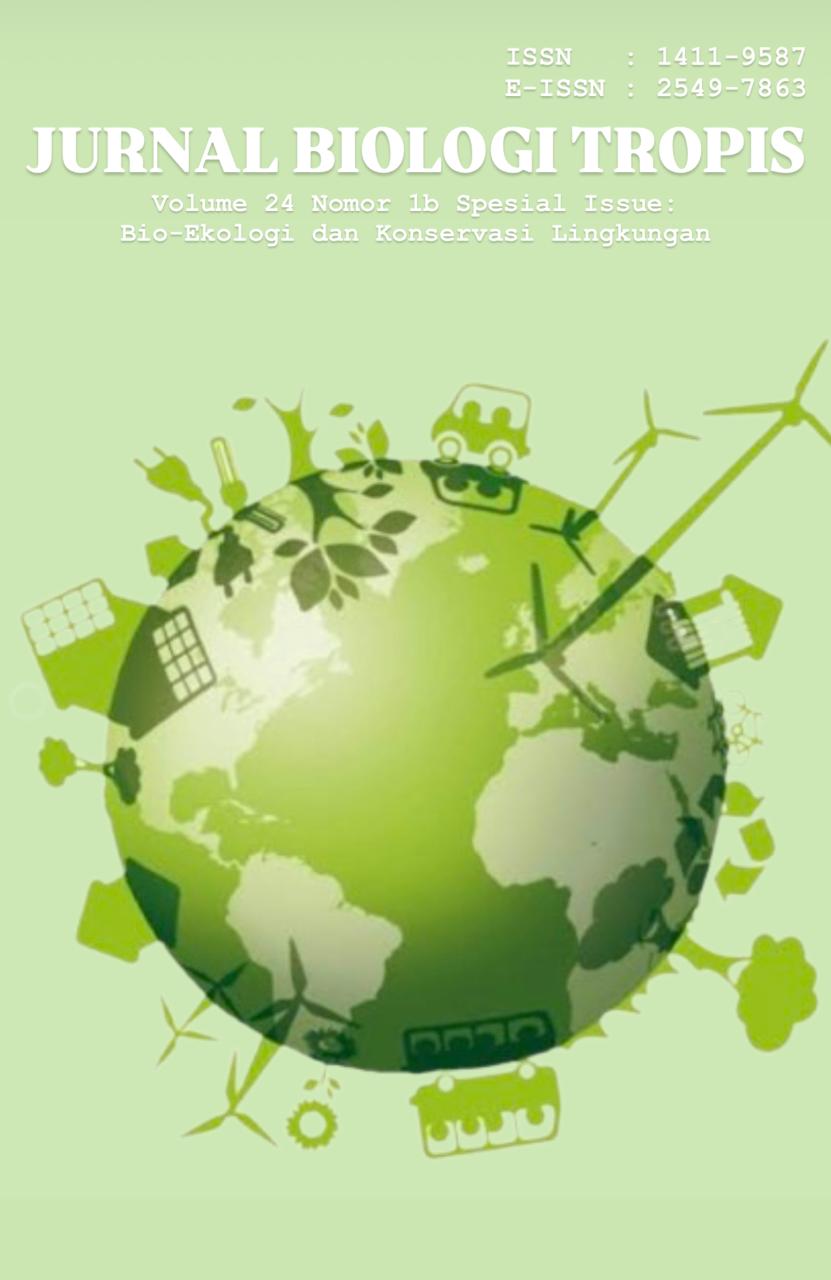Butterfly Diversity on Tanjung Trees (Mimusops Elengi L.) in Community Yard Lands
Authors
Astrid Sri Wahyuni Sumah , Ali Alamsyah KusumadinataDOI:
10.29303/jbt.v24i2b.8096Published:
2024-12-19Issue:
Vol. 24 No. 2b (2024): Special IssueKeywords:
Butterfly, diversity, Nymphalidae, pieridae.Articles
Downloads
How to Cite
Downloads
Metrics
Abstract
Butterfly diversity depends on land type, vegetation, and human intervention in the ecosystem. This is because butterflies are very sensitive and easily affected by ecological changes and variations in plant community structure. If there is a slight change in habitat, it can cause migration or extinction of butterflies. This study aims to determine the number of butterfly species diversity that visit tanjung trees (Mimusops elengi) in community yards. This study was conducted in community land on Jalan Tanjung Rawo, Bukit Lama sub-district, Ilir Barat 1 District, Palembang City. The location of the study was determined based on the exploratory method, namely insect sampling using insect nets. Based on the results of the study 25.11 individual butterflies were obtained consisting of 8 species and 2 families (Nymphalidae and Pieridae). The Pieridae family is the number of butterfly individuals most often found as many as 8.12 individuals of Appias lyncida butterflies, and the least found is Leptosia nina (0.23 individuals) which also comes from the same family. The diversity index (1.64), and the evenness index (0.788) are included in the moderate category. In addition, 10 types of plants were also found in the community's yard that support the diversity of butterflies at that location. The number of species found in the morning, afternoon, and evening did not differ much, so that the similarity of visiting species reached 87.5%. This is related to the behavior of visiting butterfly species, also related to the morphology of flowers and hidden pollen. The results of this study are expected to provide the latest information regarding the diversity of butterflies that are active in community yards with almost the same types of plants in each community yard.
References
Abrahamczyk, S., Wohlgemuth, T., Nobis, M., Nyffeler, R., & Kessler, M. (2020). Shifts in food plant abundance for flower-visiting insects between 1900 and 2017 in the canton of Zurich Switzerland. Ecology Applied, 0: e02138. https://doi.org/10.1002/eap.2138
Aguirre-Gutierrez, J., Kissling, W. D., Carvalheiro, L. G., Wallis DeVries, M.F., Franzen, M., & Biesmeijer, J. C. (2016). Functional traits help to explain half-century long shifts in pollinator distributions. Scientific Reports, 6: 24451.
Aguirre-Gutiérrez, J., Wallis DeVries, M. F., Marshall, L., van't Zelfde, M., Villalobos-Arámbula, A. R., Boekelo, B., Bartholomeus, H., Franzén, M., & Biesmeijer, J. C. (2017). Butterflies show different functional and species diversity in relationship to vegetation structure and land use. Global Ecology and Biogeography, 26 (10): 1126- 1137. https://doi.org/10.1111/geb.12622
Attaullah, M., Haq, N., Buneri, I.D., Ullah, R., & Rahim, A. (2018). Diversity of butterfly fauna of Doag Dara, Sheringal, Dir Upper, Pakistan. Journal of biodiversity and environmental sciences, 13: 297–305.
Baldock, K.C.R., Goddard, M.A., Hicks, D.M., Kunin, W.E., Mitschunas, N., Morse, H., Osgathorpe, L.M., Potts, S.G., Robertson, K.M., Scott, A.V., Staniczenko, P.P.A., Stone, G.N., Vaughan, I.P., & Memmott, J. (2019). A systems approach reveals urban pollinator hotspots and conservation opportunities. Nature Ecology and Evolution, 3: 363–373.
Banaszak-Cibicka, W., & Zmihorski, M. (2020). Are cities hotspots for bees? Local and regional diversity patterns lead to different conclusions. Urban Ecosystem, 23: 713–722. https://doi.org/10.1007/s11252-020-00972-w
Bibi, M., Bibi, S., Akhtar, N., Ullah, Z., Khan, M. F., & Qureshi, I. Z. (2022). Butterfly (Order: Lepidoptera) species Richness, diversity and distribution in different localities of Battagram, Pakistan. Saudi Journal of Biological Sciences, 29: 1853-1857. https://doi.org/10.1016/j.sjbs.2021.10.039
Borror, D. J., Triplehorn, C. A., & Johnson, N. F. (1989). An Introduction to The Study of Insects. Saunders College: Amerika.
Concepción, E. D., Obrist, M. K., Moretti, M., Altermatt, F., Baur, B., & Nobis, M. P. (2016) Impacts of urban sprawl on species richness of plants, butterflies, gastropods and birds: not only built-up area matters. Urban Ecosystem, 19: 225–242. https://doi.org/10.1007/s11252-015-0474-4
Echude, D., Amobi, M. I., Umar, S. U., Ezenwa, I. M., & Okechukwu, C. N. (2020). Checklist and comparison of butterfly species found in zoological and botanical gardens, University of Nigeria, Nsukka, Enugu State, Nigeria. Bio-Research, 18(1): 1071-1077.
Ellis, E.E., & Wilkinson, T.L. (2021). Moth assemblages within urban domestic gardens respond positively to habitat complexity, but only at a scale that extends beyond the garden boundary. Urban Ecosystem, 24: 469–479. https://doi.org/10.1007/s11252-020-01050-x
Fenner, J., Schartel, T., & Counterman, B. (2018). Lessons from Butterflies of the Black Belt Prairie: The Southern Dogface as an Indicator of Prairie Remnants. Trans America Entomology Society, 144 (2): 295-309. DOI: 10.2307/26570154
Fontaine, B., Bergerot, B., Le Viol, I., & Julliard, R. (2016). Impact of urbanization and gardening practices on common butterfly communities in France. Ecology and Evolution, 6: 8174–8180. https://doi.org/10.1002/ece3.2526
Ghani, A., & Maalik, S. (2020). Assessment of diversity and relative abundance of insect fauna associated with Triticum aestivum from district Sialkot, Pakistan. Journal of King Saud University – Science, 32: 986–995.
Gondal, W. A., & Shehzadi, A. (2024). Butterfly Fauna (Lepidoptera) Diversity in Daphar Forest Sanctuary, Mandi Bahauddin, Pakistan: A Taxonomic Checklist. Journal of Xi’an Shiyou University - Natural Science Edition, 20 (2): 250-255.
Han, D., Zhang, C., Wang, C., She, J., Sun, Z., Zhao, D., Bian, Q., Han, W., Yin, L., Sun, R., Zhao, D., Bian, Q., Han, W., Yin, L., Sun, R., Wang, X., & Cheng, H. (2021). Differences in Response of Butterfly Diversity and Species Composition in Urban Parks to Land Cover and Local Habitat Variables. Forests, 12 (2): 140. https://doi.org/10.3390/f12020140
Iqbal, W., M.F. Malik, M. Hussain, H. Ashraf, M.K. Sarwar, I. Azam, and M. Umar. (2016). Butterfly diversity; district Gujrat, Punjab, Pakistan. Journal Biology and Environment Science, 9(2): 235-243.
Lagucki, E., Burdine, J.D., & McCluney, K.E. (2017). Urbanization alters communities of flying arthropods in parks and gardens of a medium sized city. PeerJ 5: e3620. https://doi.org/10.7717/peerj.3620
Leston, L., & Koper, N. (2017). Urban right-of-way as extensive butterfly habitats: a case study from Winnipeg, Canada. Landscape and Urban Planning, 157: 56-62. https://doi.org/10.1016/j.landurbplan.2016.05.026
MacDonald, Z.G., Anderson, I.D., Acorn, J.H., & Nielsen, S.E. (2018). Decoupling habitat fragmentation from habitat loss: butterfly species mobility obscures fragmentation effects in a naturally fragmented landscape of lake islands. Oecologia 186: 11-27.
Magurran, A. E. (1988). Ecological Diversity and its Measurement. New Jersey: Princeton University Press.
Mal, B., Memon, N., Turk, J. K., Memon, S. A., Shah, M. A., & Shah, N. A. (2021). 07. Checklist of butterfly fauna (Lepidoptera: Rhopalocera) of Sindh, Pakistan. Pure and Applied Biology (PAB), 3(4): 199-203.
Martin & Bateson. (1993). Measuring Behaviour; An Introductory Guide 2nd Edition. Cambridge: Cambridge University Press
Melliger, R.L., Rusterholz, H-P., & Baur, B. (2017). Habitat- and matrix-related differences in species diversity and trait richness of vascular plants, Orthoptera and Lepidoptera in an urban landscape. Urban Ecosystem, 20: 1095–1107.
Merckx, T., & Van Dyck, H. (2019). Urbanization-driven homogenization is more pronounced and happens at wider spatial scales in nocturnal and mobile flying insects. Global Ecology and Biogeography, 28: 1440–1455. https://doi.org/10.1111/geb.12969
Murwitaningsih, S., Setyaningsih, M., Nisa, R.A., & Nurlaeni, Y. (2020). Study of butterfly diversity in Botanical Garden Indonesia. International Journal of Psychosocial Rehabilitation, 24 (08): 2271-2277. DOI: 10.37200/IJPR/V24I8/PR280247
Ojianwuna, C. C., & Enwemiwe, V. N. (2021). Spatial distribution of butterflies in different macrohabitat in a university campus in Southern-Nigeria. International Journal of Tropical Insect Science, 41(4): 2657-2668.
Peggie, D., & Amir, M. (2006). Practical Guide to Butterflies of Bogor Botanic Garden. Cibinong: LIPI.
Ramírez-Restrepo, L., & MacGregor-Fors, I. (2017). Butterflies in the city: A review of urban diurnal Lepidoptera. Urban Ecosystem, 20: 171–182.
Rembold, K., Mangopo, H., Tjitrosoedirdjo, S.S., & Kreft, H. (2017). Plant diversity, forest dependency, and alien plant invasions in tropical agricultural landscapes. Biology Conservation, 213: 234-242. DOI: 10.1016/j.biocon.2017.07.020
Rollings, R., & Goulson, D. (2019). Quantifying the attractiveness of garden flowers for pollinators. Journal of Insect Conservation, 23, 803–817.
Shrestha, B.R., Sharma, M., Magar, K.T., Gaudel, P., Gurung, M.B., & Oli, B. (2018). Diversity and status of butterflies at different sacred forests of Kathmandu valley, Nepal. Journal of Entomology Zoological Study, 6 (3): 1348–1356.
Theodorou, P., Radzevičiūtė, R., Lentendu, G., Kahnt, B., Husemann, M., & Bleidorn, C. (2020). Urban areas as hotspots for bees and pollination but not a panacea for all insects. Nature Communication, 11: 1–13.
Tzortzakaki, O., Kati, V., Panitsa, M., Tzanatos, E., & Giakos, S. (2019). Butterfly diversity along the urbanization gradient in a densely-built Mediterranean city: Land cover is more decisive than resources in structuring communities. Landscape and Urban Planning, 183: 79-87. https://doi.org/10.1016/j.landurbplan.2018.11.007
Usman, K., Rehman, H. U., Pervaiz, K., Khan, H., Ahmad, N., and Khattak, B. (2017). Exploring Butterfly fauna at Takht-e-Nasrati, Karak Khyber Pakhtunkhwa, Pakistan. Journal of Entomology and Zoology Studies, 5: 968-971.
Yu-Feng, M., Khan, Z., Perveen, F., Rafi, M. A., Shah, S. W., Xiao-Hong, S., & Xing, L. (2020). Biodiversity of Butterflies in Tangi Charsadda, Khyber Pakhtunkhwa, Pakistan. Pakistan Journal of Zoology, 52 (3): 835-841.
Author Biography
Astrid Sri Wahyuni Sumah, Program Pascasarjana Pendidikan Biologi Universitas Muhammadiyah Palembang
License
Copyright (c) 2024 Astrid Sri Wahyuni Sumah, Ali Alamsyah Kusumadinata

This work is licensed under a Creative Commons Attribution 4.0 International License.

Jurnal Biologi Tropis is licensed under a Creative Commons Attribution 4.0 International License.
The copyright of the received article shall be assigned to the author as the owner of the paper. The intended copyright includes the right to publish the article in various forms (including reprints). The journal maintains the publishing rights to the published articles.
Authors are permitted to disseminate published articles by sharing the link/DOI of the article at the journal. Authors are allowed to use their articles for any legal purposes deemed necessary without written permission from the journal with an acknowledgment of initial publication to this journal.


























